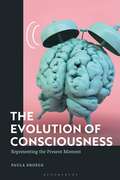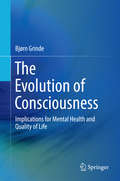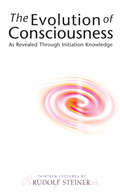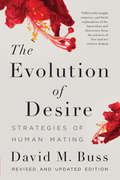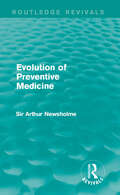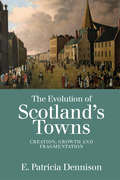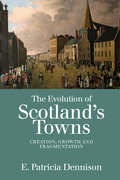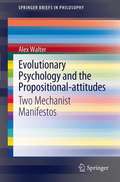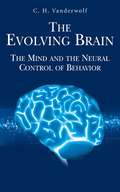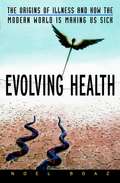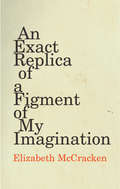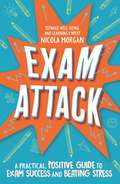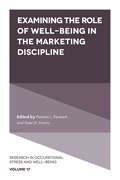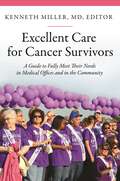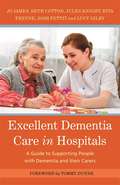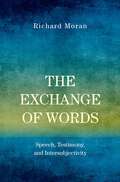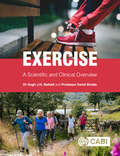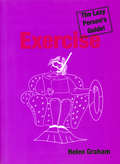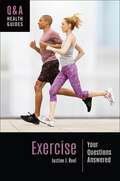- Table View
- List View
The Evolution of Consciousness: Representing the Present Moment
by Paula DroegeThe Evolution of Consciousness brings together interdisciplinary insights from philosophy, neuroscience, psychology and cognitive science to explain consciousness in terms of the biological function that grounds it in the physical world. Drawing on the novel analogy of a house of cards, Paula Droege pieces together various conceptual questions and shows how they rest on each other to form a coherent, structured argument. She asserts that the mind is composed of unconscious sensory and cognitive representations, which become conscious when they are selected and coordinated into a representation of the present moment. This temporal representation theory deftly bridges the gap between mind and body by highlighting that physical systems are conscious when they can respond flexibly to actions in the present. With examples from evolution, animal cognition, introspection and the free will debate, this is a compelling and animated account of the possible explanations of consciousness, offering answers to the conceptual question of how consciousness can be considered a cognitive process.
The Evolution of Consciousness: Representing the Present Moment
by Paula DroegeThe Evolution of Consciousness brings together interdisciplinary insights from philosophy, neuroscience, psychology and cognitive science to explain consciousness in terms of the biological function that grounds it in the physical world. Drawing on the novel analogy of a house of cards, Paula Droege pieces together various conceptual questions and shows how they rest on each other to form a coherent, structured argument. She asserts that the mind is composed of unconscious sensory and cognitive representations, which become conscious when they are selected and coordinated into a representation of the present moment. This temporal representation theory deftly bridges the gap between mind and body by highlighting that physical systems are conscious when they can respond flexibly to actions in the present. With examples from evolution, animal cognition, introspection and the free will debate, this is a compelling and animated account of the possible explanations of consciousness, offering answers to the conceptual question of how consciousness can be considered a cognitive process.
The Evolution of Consciousness: Implications for Mental Health and Quality of Life
by Bjørn GrindeThis book gives the reader an understanding of what consciousness is about, and of how to make conscious experiences more pleasant. It expands on a new theory that describes the evolutionary trajectory leading to conscious life forms. In short, the evidence suggests that consciousness first evolved some 300 million years ago as a consequence of the introduction of feelings. Feelings offer a strategy for making behavioural decisions. Besides playing a crucial role in the evolution of the human mind, they are a key factor in regard to mental health and quality of life. Fortunately, the human brain is plastic. By exploiting available options for modulating the mind, it is therefore possible to impact on what sort of experiences the brain serves. More specifically, you can strengthen the capacity for positive feelings and reduce the sway of negative feelings. The text covers biological, neurological, psychological, and philosophical aspects of the mind.
The Evolution of Consciousness: As Revealed Through Initiation Knowledge
by Rudolf SteinerAccording to the initiate-research of Rudolf Steiner, humanity is in a continual process of transformation and evolution. Modern-day consciousness, based as it is on sense perception and abstract logic, differs considerably from the consciousness of ancient humanity. At that time, says Steiner, the human being was seen to be a microcosm, a concentration of the laws and activities of the cosmos. The loss of such knowledge today has led to the existential quest for meaning, and even the cul-de-sac of atheism.In these comprehensive lectures, delivered to an English audience, Rudolf Steiner indicates how it is possible for people to rediscover their connection to the cosmos. He describes how one develops higher faculties of consciousness - what he calls Imagination, Inspiration and Intuition - and gives a vivid description of life after death and the individual's progress through the planetary spheres. It is in these spheres, he explains, where tasks and goals for future incarnations are prepared in cooperation with the spiritual beings of the heavenly hierarchies.The lectures culminate in a call for mankind to take its own destiny in hand through conscious and free development of spiritual capacities.The edition of this fundamental work features a revised translation as well as previously-unavailable addresses and question-and-answer sessions.
The Evolution of Desire: Strategies of Human Mating
by David M. BussThe groundbreaking, provocative book that uses evolutionary psychology to explain human mating and the mysteries of love.If we all want love, why is there so much conflict in our most cherished relationships? To answer this question we must look into our evolutionary past, argues prominent psychologist David M. Buss. Based one of the largest studies of human mating ever undertaken, encompassing more than 10,000 people of all ages from thirty-seven cultures worldwide, The Evolution of Desire is the first work to present a unified theory of human mating behavior. Drawing on a wide range of examples of mating behavior -- from lovebugs to elephant seals, from the Yanomamö tribe of Venezuela to online dating apps -- Buss reveals what women want, what men want, and why their desires radically differ. Love has a central place in human sexual psychology, but conflict, competition, and manipulation also pervade human mating -- something we must confront in order to control our own mating destiny.Updated to reflect the very latest scientific research on human mating, this definitive edition of this classic work of evolutionary psychology explains the powerful forces that shape our most intimate desires.
Evolution of Preventive Medicine (Routledge Revivals)
by Sir Arthur NewsholmeFirst published in 1927, this book provides a complete study of the beginnings and early development of preventive medicine. It looks at the subject’s underlying principles and discusses the prominent writers of the past. Topics cover infection, plague, science and medicine, poverty and preventive medicine and the prevention of cholera, amongst others.
Evolution of Preventive Medicine: Being A Continuation Of The Evolution Of Preventive Medicine (Routledge Revivals)
by Sir Arthur NewsholmeFirst published in 1927, this book provides a complete study of the beginnings and early development of preventive medicine. It looks at the subject’s underlying principles and discusses the prominent writers of the past. Topics cover infection, plague, science and medicine, poverty and preventive medicine and the prevention of cholera, amongst others.
The Evolution of Scotland’s Towns: Creation, Growth and Fragmentation
by Patricia DennisonExamines Francoist and Post-Francoist Spanish cinema through the lens of kitsch aesthetics
The Evolution of Scotland’s Towns: Creation, Growth and Fragmentation
by Patricia DennisonA new analysis of mind/body unity, based on the philosophy of Spinoza
Evolutionary Psychology and the Propositional-attitudes: Two Mechanist Manifestos (SpringerBriefs in Philosophy)
by Alex WalterThe two essays provide a critical examination of theory and research in the field of evolutionary psychology. The view advanced here is that philosophical materialism and minimalist assumptions about adaptation serve Darwinian psychology better than the more popular alternative view that relies on cognitive dualism and propositional-attitude psychology to formulate evolutionary psychology theory. A commitment to cognitive dualism is destined to undermine the physical basis of behavior upon which evolutionary theory depends. Many evolutionary psychologists do not see this but are seduced by the easy way in which hypotheses can be formulated using the ‘propositional-attitude’ model. The challenge is to develop a materialistic and mechanistic approach to understanding human cognition and behavior, including linguistic and social behavior.
The Evolving Brain: The Mind and the Neural Control of Behavior
by C. H. VanderwolfThis book presents a series of essays on neuroscientific aspects of human nature and instinctive behavior, individually acquired (learned) behavior, human bipedal locomotion, voluntary movement, and the general problem of how the brain controls behavior. The author argues that concepts of the mind based on ancient Greek philosophy are past usefulness, and that modern animal behavior studies provide a better guide to the functional organization of the brain.
Evolving Health: The Origins of Illness and How the Modern World Is Making Us Sick
by Noel T. BoazHuman illnesses can be understood as damage to those adaptations that we took on at various stages in our evolution from pre-life molecules to modern Homo sapiens. Preventing these illnesses entails avoiding what causes the damage-- which too frequently are the everyday hazards of twenty-first-century life, as the chart below shows: Level of Evolution Cause of adaptive failure resulting disease or problem Pre-life Environmental poisons Certain birth defects Single cell (bacteria and amoeba-like) Viral infection Colds/flu/HIV Morula (sponge-like) Cellular stress Cancer Chordate Physical stress Back pain Fish Excess dietary salt Hypertension/heart disease Amphibian Tobacco smoke Lung cancer/emphysema Lower primate Excess dietary sugar Diabetes mellitus Higher primate Vitamin C deficiency Scurvy Ape Excess dietary protein Gout Homo sapiens Reduced dietary variety Nutritionaldiseases/food allergies
An Exact Replica of a Figment of My Imagination: A Memoir
by Elizabeth McCracken'This is the happiest story in the world with the saddest ending.'A prize-winning, successful novelist in her 30s, Elizabeth McCracken was happy to be an itinerant writer and self-proclaimed spinster. Then she fell in love, got married, and continued her life of writing, travelling, and teaching with her husband.Two years ago, she found herself in a remote part of France, waiting for the birth of her first child.This book is about what happens next. In the ninth month of her pregnancy, a baby is lost.Just over a year later, a baby is born. In a profoundly moving display of humour, heart, and unfailing generosity, McCracken tenderly presents her story: a story of true love and unfathomable sadness, of courageous recovery and bittersweet moments, of steadfast memories and deep affection.Grief walks through these pages of this remarkable book, but so do happiness and hope.
Exam Attack
by Nicola MorganA practical, positive, utterly sensible guide for exam students, for the best chance of success.Exams are stressful and most people don't love them! This book can't remove all your exam nerves and, anyway, a certain level of stress can help you perform well. Instead this book aims to help you avoid bad stress and have the greatest chance of doing your best when exams arrive. It will give you the tools to control your body and mind during this challenging phase. And the tools will help you at many other stressful times of life.Exam Attack covers a huge range of learning techniques. You'll find advice on food (and how to cope when you lose your appetite), sleep, panic, revision, getting help, managing screens and social media. And there's up-to-date advice on note-taking and learning.One of the core principles in this book is that our mental and physical health, or 'wellbeing', affects how we perform. It isn't a luxury or optional extra: it affects every aspect of life.
Examining the Role of Well-Being in the Marketing Discipline (Research in Occupational Stress and Well Being #17)
by Pamela L. Perrewé Peter D. HarmsVolume 17 of Research in Occupational Stress and Well Being is focused on the stress and well-being related to the marketing discipline. This volume is focused on the connections between employee stress, health, and well-being as it relates to marketing, sales, and customers. We have 7 chapters devoted to critical topics such as internal selling, stress at the consumer-employee interface, how leaders can affect the customer experience, and the unique stressors associated with being a persuasion agent. Further, we have two comprehensive empirical reviews of topics in this domain. The first examines the degree to which positive psychology constructs relate to sales performance. The second examines customer mistreatment towards employees and how it impacts their well-being. The final chapter takes a more practitioner perspective and examines the importance of taking into account stress tolerance when selecting and training sales personnel. The objective of this series is to promote theory and research in the increasingly growing area of occupational stress, health and well-being, and in the process, to bring together and showcase the work of the best researchers and theorists who contribute to this area. Questions of work stress and well-being span many disciplines and many specialized journals. One of the virtues of this series has been to provide a multidisciplinary and international platform that gives a thorough and critical assessment of knowledge, and major gaps in knowledge, on occupational stress and well-being.
Examining the Role of Well-Being in the Marketing Discipline (Research in Occupational Stress and Well Being #17)
by Pamela L. Perrewé Peter D. HarmsVolume 17 of Research in Occupational Stress and Well Being is focused on the stress and well-being related to the marketing discipline. This volume is focused on the connections between employee stress, health, and well-being as it relates to marketing, sales, and customers. We have 7 chapters devoted to critical topics such as internal selling, stress at the consumer-employee interface, how leaders can affect the customer experience, and the unique stressors associated with being a persuasion agent. Further, we have two comprehensive empirical reviews of topics in this domain. The first examines the degree to which positive psychology constructs relate to sales performance. The second examines customer mistreatment towards employees and how it impacts their well-being. The final chapter takes a more practitioner perspective and examines the importance of taking into account stress tolerance when selecting and training sales personnel. The objective of this series is to promote theory and research in the increasingly growing area of occupational stress, health and well-being, and in the process, to bring together and showcase the work of the best researchers and theorists who contribute to this area. Questions of work stress and well-being span many disciplines and many specialized journals. One of the virtues of this series has been to provide a multidisciplinary and international platform that gives a thorough and critical assessment of knowledge, and major gaps in knowledge, on occupational stress and well-being.
Excellent Care for Cancer Survivors: A Guide to Fully Meet Their Needs in Medical Offices and in the Community (The Praeger Series on Contemporary Health and Living)
by Kenneth D. MillerA clear, concise, and essential guide providing key information about cancer survivors and their needs—and how those needs can best be met.Excellent Care for Cancer Survivors: A Guide to Fully Meet Their Needs in Medical Offices and in the Community is edited by the director of the Lance Armstrong Cancer Survivorship Program at the Dana Farber Cancer Institute and comprised of articles by experts from that prestigious institution, from the Harvard Medical School, and other leading cancer programs. Its goal is simple: to assure that the millions of cancer survivors in the United States get the help they need to live life to its fullest. This timely work, enriched by conversations with cancer survivors themselves, explains the array of challenges that may affect survivors, from physical needs to psychological, spiritual, sexual, and financial issues. Topics such as nutrition and exercise are also addressed, as are risk assessment, rehabilitation, and possible cognitive dysfunction after chemotherapy. A final section explains the nuts and bolts of starting a professional cancer survivorship program, from staffing to fundraising, exploring what can and is being done to help cancer survivors in different settings achieve optimal health and quality of life.
Excellent Dementia Care in Hospitals: A Guide to Supporting People with Dementia and their Carers (PDF)
by Bethany Cotton Jo James Josh Pettit Jules Knight Julia Jones Lucy Gilby Nicci Gerard Rita Freyne Tommy DunnePeople with dementia increasingly find themselves staying in hospitals for extended periods, and dementia is often only diagnosed on admission to hospital for a separate health issue. This practical guide presents healthcare staff with the information and tools needed to provide excellent person-centred care to people with dementia in hospital settings. This best-practice handbook includes information and innovative strategies on how to manage common issues, including communication, physical health needs, pain, eating and nutrition, working with carers and relatives, understanding behaviour and approaching the end of life. It also highlights ethical considerations such as human rights and dementia, making decisions and the Mental Capacity Act. Each chapter includes a case study, emphasising the person at the centre of care and providing worked examples of how hospital staff can work with people with dementia to ensure best practice.
Excellent Dementia Care in Hospitals: A Guide to Supporting People with Dementia and their Carers
by Tommy Dunne Rita Freyne Nicci Gerard Lucy Gilby Julia Jones Jules Knight Josh Pettit Jo James Bethany CottonPeople with dementia increasingly find themselves staying in hospitals for extended periods, and dementia is often only diagnosed on admission to hospital for a separate health issue. This practical guide presents healthcare staff with the information and tools needed to provide excellent person-centred care to people with dementia in hospital settings. This best-practice handbook includes information and innovative strategies on how to manage common issues, including communication, physical health needs, pain, eating and nutrition, working with carers and relatives, understanding behaviour and approaching the end of life. It also highlights ethical considerations such as human rights and dementia, making decisions and the Mental Capacity Act. Each chapter includes a case study, emphasising the person at the centre of care and providing worked examples of how hospital staff can work with people with dementia to ensure best practice.
The Exchange of Words: Speech, Testimony, and Intersubjectivity
by Richard MoranThe capacity to speak is not only the ability to pronounce words, but the socially-recognized capacity to make one's words count in various ways. We rely on this capacity whenever we tell another person something and expect to be believed, and what we learn from others in this way is the basis for most of what we take ourselves to know about the world. In The Exchange of Words, Richard Moran provides a philosophical exploration of human testimony as a form of intersubjective understanding in which speakers communicate by making themselves accountable for the truth of what they say. The book brings together themes from literature, philosophy of language, moral psychology, action theory, and epistemology, for a new approach to this fundamental human phenomenon. The account developed here starts from the difference between what may be revealed in one's speech (like a regional accent) and what we explicitly claim and make ourselves answerable for. Some prominent themes include: the meaning of sincerity in speech, the nature of mutuality and how it differs from 'mind-reading', the interplay between the first-person and the second-person perspectives in conversation, and the nature of the speech act of telling and related illocutions as developed by philosophers such as J. L. Austin and Paul Grice. Everyday dialogue is the locus of a kind of intersubjective understanding that is distinctive of the transmission of reasons in human testimony, and The Exchange of Words is an original and integrated account of this basic way of being informative to and in touch with one another.
EXCHANGE OF WORDS C: Speech, Testimony, and Intersubjectivity
by Richard MoranThe capacity to speak is not only the ability to pronounce words, but the socially-recognized capacity to make one's words count in various ways. We rely on this capacity whenever we tell another person something and expect to be believed, and what we learn from others in this way is the basis for most of what we take ourselves to know about the world. In The Exchange of Words, Richard Moran provides a philosophical exploration of human testimony as a form of intersubjective understanding in which speakers communicate by making themselves accountable for the truth of what they say. The book brings together themes from literature, philosophy of language, moral psychology, action theory, and epistemology, for a new approach to this fundamental human phenomenon. The account developed here starts from the difference between what may be revealed in one's speech (like a regional accent) and what we explicitly claim and make ourselves answerable for. Some prominent themes include: the meaning of sincerity in speech, the nature of mutuality and how it differs from 'mind-reading', the interplay between the first-person and the second-person perspectives in conversation, and the nature of the speech act of telling and related illocutions as developed by philosophers such as J. L. Austin and Paul Grice. Everyday dialogue is the locus of a kind of intersubjective understanding that is distinctive of the transmission of reasons in human testimony, and The Exchange of Words is an original and integrated account of this basic way of being informative to and in touch with one another.
Exercise: A Scientific and Clinical Overview
by Dr Hugh J. Bethell Professor David BrodieThis book is about exercise - what it is, how it affects the individual, how it is measured and most of all what benefits it brings. Beginning with an introduction to the history and biology of exercise, the authors review the interactions between exercise and specific diseases, such as diabetes, coronary heart disease, cancer and many more, before considering exercise in a wider health context. The book covers: - Current societal norms, as well as the social and economic costs of inactivity. - Exercise for life - from starting young, to pregnancy, longevity and frailty. - Complications of exercise. - The intersections of behavioural psychology and exercise, such as encouragement and excuse making. With comprehensive and clear explanations based on sound science, yet written in an approachable and accessible style, this book is a valuable resource for students of medicine, public health, physiotherapy, sports science, coaching and training.
Exercise: Relax Your Way to Better Health and Fitness
by Helen GrahamFed up with feeling guilty about not doing those regular workouts you’ve been promising to start? We know that exercise is good for us, but why does it have to be such hard work?Helen Graham is here to tell you it doesn’t have to be: it’s possible to achieve results with a much more gentle and balanced approach to fitness. An accessible guide to everything from yogic breathing to pilates and dynamic relaxation, Exercise: The Lazy Person’s Guide! is a must for those of us looking for an effortless remedy: a way to exercise without doing very much at all!The Lazy Person’s Guide! is a series of popular, cheerful yet thoroughly grounded, practical and authoritative books on various health issues and conditions. Other titles in the series include Beating Overeating, Detox, Improving Your Memory, Midlife, Quitting Smoking, Self-esteem and Stress. Other books by Helen Graham include Healing with Colour, Make Stress Work for You and Soul Medicine.Exercise: The Lazy Person's Guide!: Table of ContentsIntroductionHaving a Lie DownTaking a BreatherSounds RelaxingTaking It EasyLetting Your Mind WanderStretch YourselfGetting a Move OnGoing Further
Exercise: Your Questions Answered (Q&A Health Guides)
by Justine J. ReelThis book answers readers' most pressing questions about exercise and physical activity and will serve as a valuable resource to anyone interested in starting and maintaining healthy habits in this important area of health.Whether it's going for a run or to a yoga class, playing basketball with friends, or spending an afternoon doing yardwork, moving our bodies regularly is vital for both our physical and mental well-being. This book explores the different forms of exercise and physical activity, their benefits and risks, why so many people find it difficult to be physically active, and how to create and maintain a healthy, sustainable plan for physical activity.Books in Greenwood's Q&A Health Guides series follow a reader-friendly question-and-answer format that anticipates readers' needs and concerns. Prevalent myths and misconceptions are identified and dispelled, and a collection of case studies illustrates key concepts and issues through relatable stories and insightful recommendations. Each book also includes a section on health literacy, equipping teens and young adults with practical tools and strategies for finding, evaluating, and using credible sources of health information both on and off the internet—important skills that contribute to a lifetime of healthy decision-making.
Exercise: Your Questions Answered (Q&A Health Guides)
by Justine J. ReelThis book answers readers' most pressing questions about exercise and physical activity and will serve as a valuable resource to anyone interested in starting and maintaining healthy habits in this important area of health.Whether it's going for a run or to a yoga class, playing basketball with friends, or spending an afternoon doing yardwork, moving our bodies regularly is vital for both our physical and mental well-being. This book explores the different forms of exercise and physical activity, their benefits and risks, why so many people find it difficult to be physically active, and how to create and maintain a healthy, sustainable plan for physical activity.Books in Greenwood's Q&A Health Guides series follow a reader-friendly question-and-answer format that anticipates readers' needs and concerns. Prevalent myths and misconceptions are identified and dispelled, and a collection of case studies illustrates key concepts and issues through relatable stories and insightful recommendations. Each book also includes a section on health literacy, equipping teens and young adults with practical tools and strategies for finding, evaluating, and using credible sources of health information both on and off the internet—important skills that contribute to a lifetime of healthy decision-making.
